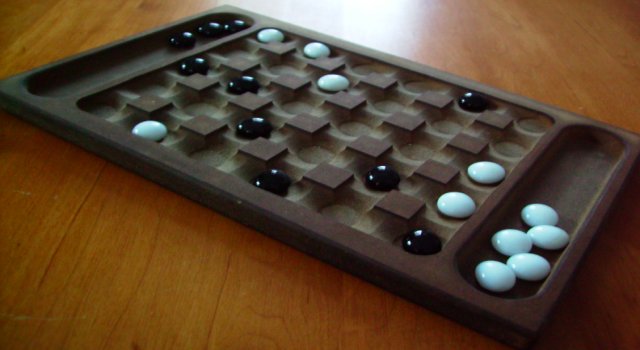Yoté West African Board Game
Deeply rooted in the cultural fabric of West Africa, particularly in countries like Mali and Senegal, lies Yoté – a captivating strategy board game that has entertained and challenged generations. Its origins are lost in antiquity, but first became known in the west towards the end of the nineteenth century. Although nowadays played on a board, it is believed that originally it was played by scooping holes out of the sand and using pebbles and pieces of stick for pieces although shells and large seeds were also used.
More than just a pastime, Yoté is a vibrant component of social gatherings, a tool for developing strategic thinking, and a testament to the rich tradition of abstract games on the continent. You would be forgiven when first playing Yoté that it's somewhat like checkers, but it's more complex and strategic. At its core, Yoté is a game of capture, and is typically played on a 5x6 (or sometimes 6x5) grid. Each of the two players starts with twelve pieces known as 'elephants', aiming to capture all of their opponent's pieces.
The rules of Yoté are deceptively simple, yet they unlock a complex strategic landscape. At the beginning of the game, the board is blank and players take turns moving one of their pieces one step orthogonally (horizontally or vertically) to an adjacent empty square. The objective is to capture the opponent's pieces, but the method of capture is what truly sets Yoté apart. A piece is captured when an opponent's piece is moved to an adjacent square, and there is an empty square directly beyond the captured piece in the same line.
Here's where the unique Yoté twist comes in: when a player captures an opponent's piece, they don't just remove that single piece. Instead, the capturing player gets to remove an additional piece of their choice from any of the opponent's pieces currently on the board. This "capture two" rule makes Yoté an incredibly aggressive and dynamic game, forcing players to constantly consider the potential loss of multiple pieces with every move.
Another fascinating rule adds further strategic layers: if a player finds themselves unable to make any valid move (i.e., all adjacent squares to their pieces are occupied), they are not stuck. Instead, they must take one of their unused reserve pieces and place it onto any empty square on the board. This rule can open up new pathways, create defensive strongholds, or even set up future captures, adding an unpredictable element to the endgame. The player who captures all the opponent's pieces is the winner. The game can also end in a draw if both players are left with three or fewer pieces.
Beyond its intricate rules, Yoté holds significant cultural value. It is often played in public spaces, under trees, or in village compounds, fostering social interaction and a sense of community. The game teaches patience, foresight, and adaptability – qualities highly valued in everyday life. Children learn critical thinking and problem-solving skills by observing and participating in games, ensuring the tradition is passed down through generations.
In a globalised world, traditional games like Yoté serve as important cultural anchors, preserving heritage and offering a unique window into the ingenuity of African thought. Its enduring popularity is a testament to its elegant design, strategic depth, and the simple joy it brings to players. Yoté is more than just a game; it's a piece of living history, continuously played and cherished across West Africa. You might find it useful to have a look at the video (left) which explains how to play Yote in more detail. |

